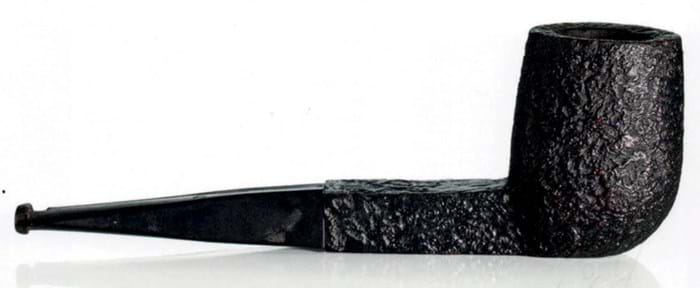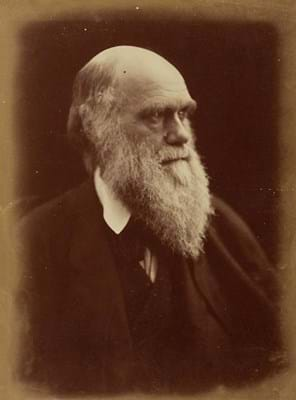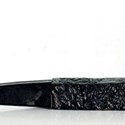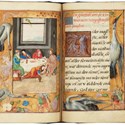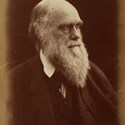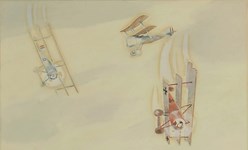A few highlights from three of the London auctions, all of which will feature again in further ATGs, are noted here. However, much more was on offer and future issues will include reports focusing on various aspects of natural history, bindings, bibles and so on.
Sales of illuminated and other early manuscripts, including those sold in specialist auctions at Sotheby’s and Dreweatts/Bloomsbury, will also feature. A spread from one exceptional prayerbook in the New Bond Street sale is, however, featured this week.
A third selection of books from Pierre Bergé’s remarkable library, sold at his own saleroom in Paris on June 28, and a varied selection of material from other European and American summer sales are all included in the mix.
And future issues will, of course, feature unusual or exceptional lots drawn from sales held across the UK and Ireland.
Special prices
At Christie’s (25/20/12% buyer’s premium) on July 12, Einstein, Darwin and St Ignatius de Loyola were among the leading players.
Five (of six) letters addressed by Einstein to Michele Besso, his oldest and closest friend, and the only acknowledged collaborator on his ground-breaking theory of special relativity, raised £483,000 in all.
The most important of them was a 1916 letter presenting a detailed explanation of the development of one of his more famous concepts, the cosmological constant. Sold for £240,000, it explains in detail his reasoning behind the concept’s introduction into the equations of general relativity.
In an online sale that ended on July 6, a further $1.7m (£1.3m) had been raised by Sotheby’s New York on a sale offering a further 50 letters from Besso, with more to come at a later date.
See also the Einstein pipe (from a different property) illustrated top, which sold for £50,000 in London.
Though the previous day’s sale at Sotheby’s had boasted a major Darwin collection, it was at King Street that a record £220,000 was paid for an 1859 first of On the Origin of Species….
This was a copy that also came with a portrait carte de visite and a letter – written by his wife, Emma, but signed by Charles. The latter was sent in 1874 to an un-named correspondent, but one who is assumed to be the anti-Darwinian German botanist, Albert Wigand, as it refers to a replacement for a lost copy of one of Wigand’s books.
A few major items among the early printed books in the Christie’s sale were left unsold, among them an exceptionally rare 1486, Ulm edition of Eunuchus, a comic play by the Roman dramatist Terence that marked the earliest printing of any classical play in the vernacular. It had been estimated at £200,000- 300,000.
A 1495-98 edition of the works of Aristotle, the editio princeps of the Greek texts and the greatest achievement of Aldus Manutius’ Venice press, failed on a £300,000- 500,00 estimate.
The most costly disappointment, though, was a spectacular example of the most famous early botanical study ever published. Estimated at £600,000-900,000, this was a luxuriously coloured copy of Besler’s Hortus Eystettinsis that was dedicated and presented to his patron, the Prince Bishop of Eichstatts, on whose gardens it was based.
However, a 1548 first of a famous work on “ascetic discipline, the nature of sin and Christian perfection by grace”, the Exercitia Spiritualia of St Ignatius de Loyola, sold at a record £245,000. This great rarity was last seen at auction less that three years ago, having made $200,000 (then £127,390) in a 2014 sale held by Christie’s New York.
A 1611 first of the King James Bible sold for what may well be a record £135,000, and £55,000 was certainly a record for a 1644 first of Milton’s great defence of the freedom of expression, Areopagitica…
The unsightly appearance of a Torquay Natural History Society stamp on the title and a list of library laws pasted on the facing page were not its greatest selling points, but it boasted a good 18th century binding of sprinkled calf gilt.
Like a few other recorded copies, this one also has corrections on a couple of pages that are believed to be in Milton’s hand.
Taking the chair
The surprise lot in the Sotheby’s (25/20/12.5% buyer’s premium) sale of July 11 came early in the proceedings, when four leaves of notes on classical Chinese literature in the hand of Mao Zedong sold for £580,000 rather than the predicted £60,000-80,000.
A very different autograph lot, a letter written (in the third person) by Jane Austen, sold for a record £130,000 – just overtaking a letter sent to her sister Cassandra that made £10,000 less in the same rooms only last December.
Addressed to her niece, Anna, this 1812 letter was described as a masterly comic jeu d’esprit, written as if it was to be sent to Rachel Hunter, the author of a verbose Gothic novel called Lady Maclairn, the Victim of Villainy.
This was a work that Anna’s daughter, Fanny-Caroline, later described as “a voluminous and most tiresome novel”, one that Jane and her mother had been reading and laughing over together.
Other records were set by exceptional copies of works by writers as diverse as Byron, Dickens and JK Rowling: Don Juan at £19,000, The Chimes at £23,000 and an uninscribed but fine first of Harry Potter and the Philosopher’s Stone at £22,000.
Closer examination will doubtless reveal other records in this and other fields, but I will note here just a copy of Adam Smith’s first book, The Theory of Moral Sentiments of 1759 that sold for £26,000 as part of the
160-lot selection of books from the much larger and more broadly based Garrett Herman collections.
The principal focus in this selection was ‘The Age of Darwin’, and while a very fine example of On the Origin of Species… that sold for £130,000 was not a record breaker – as noted earlier – others certainly appeared.
One was an 1842 first of The Structure and Destruction of Coral Reefs…, the first part of Darwin’s account of the geology of the Beagle voyage. Inscribed in a clerk’s hand as a gift from Darwin to a Dr John Forres, it sold at £32,000.
Another was On the Tendency of Species to form Varieties…, the joint announcement by Darwin and Alfred Russel Wallace of their independent studies in evolution by natural selection. This 17pp extract from the Journal… of the Linnaean Society, bound in modern morocco, sold at £22,000.
Sister act

With the price of four shillings (4/-) added beneath the gilt lettered title, this 1846 first issue copy of the Brontë sisters’ Poems…, containing a short note from Charlotte to the publishers, sold at Forum Auctions for £45,000.
The principal literary attraction of a July 10 sale held by Forum Auctions (25/20/12% buyer’s premium) was a 75-lot Brontë collection.
Sold for a record £45,000 was one of no fewer than three first edition copies of the sisters’ first published work, a volume of Poems issued in 1846. Containing 61 poems by Charlotte, Emily and Anne but published as the work of Currer, Ellis and Acton Bell, the first issue of 1000 copies was published at their own expense, £31.10s.0d, but initially only two copies sold!
Some others they sent to favourite authors in the hope of boosting sales, but to no avail, and 961 copies remained unsold until acquired for re-issue by Smith & Elder from the original publishers, Aylott & Jones.
A brief letter from Charlotte to the latter was tipped into this copy, which in its last auction appearance in 1979, as part of the Arthur Houghton library, made £3500 at Christie’s.
Sold for £16,000 was the ex- Bradley Martin copy of that S&E re-issue of 1848, in its own green binding but for some reason retaining the original A&J title-page. The surprise bid, however, came for a copy of Smith & Elder’s second re-issue of that same year, estimated at just £1000-1500 but sold at £28,000.
The reason? The ownership inscription of Charlotte’s lifelong friend and correspondent, Ellen Nussey. Other surprises also emerged, and this important Brontë collection is one to which I will return.


